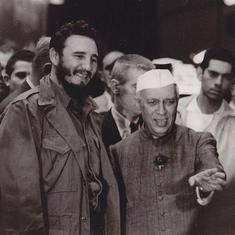In the first clip, well-known Kabir panthi singer Prahlad Singh Tipaniya renders nirgun bhajans extolling the virtues of the guru. The bhajan is based on the nirgun philosophy that dwells on the search for a path to attain oneness with the ultimate truth that has no attributes.
Prahlad Tipaniya: Bin guru gyan na paave, Kabir bhajan
The next bhajan expresses a deep sense of gratitude that the seeker has for the guru in revealing the path to the truth. Written by Devnath, a Nath panthi poet, it is sung by the inimitable non-conformist vocalist Kumar Gandharva.
Kumar Gandharva: Guruji Jahan Baithoon Wahan Chhaya Ji, nirguani bhajan
The guru occupies a high status in knowledge systems that are primarily orally transmitted, simply because he or she is the giver and interpreter of the knowledge. That is not to say that there is an absence of textual sources, but these are often commentaries on the practical aspect that is always a step ahead of the written word. Theoretical works that take on a prescriptive role are also secondary when the prime mover in the transmission of knowledge is the guru-shishya parampara or the master-disciple tradition.
The guru-shishya parampara has been the preferred and time-tested choice for training students of Hindustani music who wish to pursue it as a profession. For amateurs, institutionalised teaching, developed through the nineteenth and twentieth centuries, has been the more accessible way. Both systems have their merits and demerits, and scholars and practitioners have been vocal with their concerns about both.
Despite that, the guru continues to play a vital role in the life of a disciple, for it is the guru who is believed to be the only person who can unravel the mysteries of the theory and philosophy of music and hand it down to the disciple. In this sense, the guru is considered to be not just the provider of information, but a transmitter of knowledge and wisdom that dates back many generations.
It is for this reason that guru-purnima is celebrated with much verve in the month of Ashadh according to the Hindu calendar. This year, guru-purnima will be observed on July 31.
Not surprisingly, there are several compositions in the Hindustani repertoire that reflect the pre-eminence of the guru. One such composition has been included as the first piece on this track. Sung by renowned vocalist Ustad Amir Khan, this madhya laya, or medium-paced, composition is in Marwa, a raag prescribed to be performed at the twilight hour. This composition set to Teen taal, a cycle of sixteen matras, or time-units, is followed by another in raag Darbari Kanada, but which does not pertain to the theme under discussion.
Ustad Amir Khan: Guru bin gyan na pave, raag Marwa
Next week, this column will feature the music of a respected scholar-musician who is considered by many as the quintessential shishya and an ideal guru.










